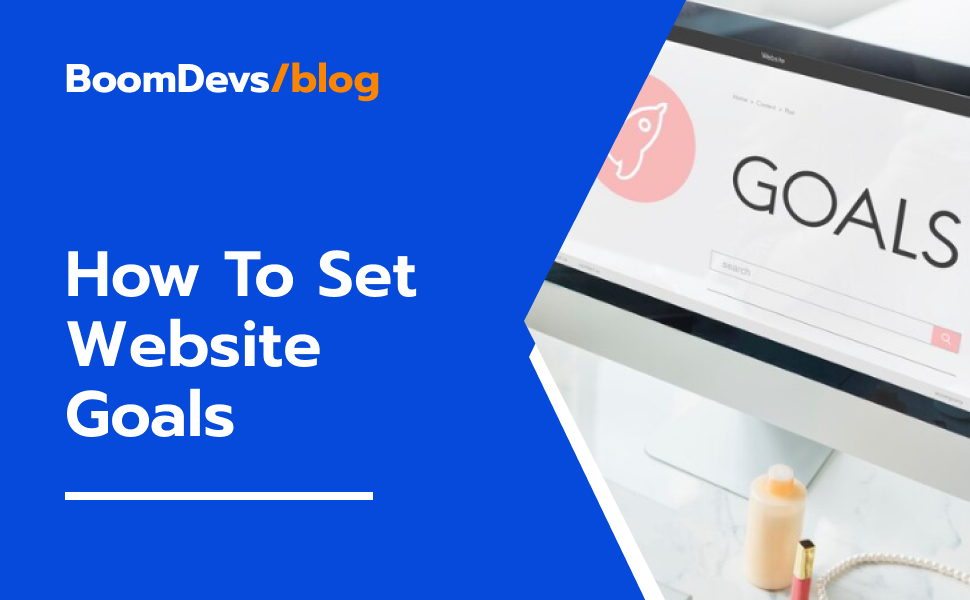Setting website goals is one of the most important steps for making your website successful. Without clear goals, your website might not perform well, and you could miss out on growth. In this guide, we will explain how to set website goals in simple steps, so anyone can follow along and understand.
Whether you have a business, blog, or online store, having goals will help you focus on what matters, track your progress, and get better results. In today’s world, just having a website isn’t enough. Your website needs to achieve specific results that help your business grow.
By setting S.M.A.R.T. goals—Specific, Measurable, Attainable, Relevant, and Time-bound—you can build a website that attracts visitors and turns them into customers. This easy-to-follow guide will show you how to set, track, and reach your website goals step by step. Let’s start building your path to success!
Why Is Your Website Important
Your website is very important because it helps people learn about your business. Many consumers research online before buying something, and your website is where they go to find out more. It provides them with information, answers questions, and shows the benefits of what you offer.

Your website is also a key part of the sales process. It helps guide visitors from learning about your products to deciding to buy. A well-designed website offers a smooth and helpful experience that encourages customers to take action, like making a purchase or filling out a contact form.
For your website to truly help your business, it needs to have a clear purpose. This means setting goals, like getting more visitors, increasing sales, or collecting leads. If your website doesn’t have a clear purpose, it might not give the results you need.
What Are Website Goals?
Website goals are the specific things you want your website to achieve. These can include getting more visitors, making more sales, or improving how easy your site is to use. Having clear goals helps you know what to focus on and how to measure your success.
For example, instead of just wanting “more visitors,” a better goal would be to “increase visitors by 20% in the next three months.” This way, you can easily track your progress.
Your website goals should also match your overall business goals and meet your audience’s needs. Following the SMART method (Specific, Measurable, Achievable, Relevant, and Time-bound) will help make your goals clear and easier to reach.
Why Website Goals Are Important
Website goals are important because they give your site a clear purpose and direction. Without clear goals, you won’t know if your website is performing well or if it’s helping your business grow. Setting goals allows you to measure success and understand what you want to achieve, whether that’s getting more visitors, boosting sales, or improving user experience.

Your website plays a key role in the consumer research process. Most customers visit websites to gather information before making a purchase decision. By setting goals, you can guide them through this process, answering their questions and showcasing the value of your products or services.
A website is also a critical part of the sales funnel. It helps move visitors from awareness to decision-making stages. When your website has specific goals, like increasing conversions or enhancing user experience, it works toward a purpose, ensuring that it generates real results for your business.
Types of Website Goals
Website goals help guide your website to success by focusing on what you want to achieve. These goals can be divided into different types depending on what your website needs. Here are some common types of website goals explained in simple terms:
1. Traffic Goals
Traffic goals are focused on bringing more visitors to your website. If your website doesn’t get enough visitors, it won’t be able to grow, generate leads, or make sales. Traffic is the lifeblood of a website, and setting traffic goals ensures that you’re working to attract more people.
Examples of Traffic Goals:
- Increase website traffic by 30% in six months.
- Grow organic search traffic by improving SEO (Search Engine Optimization).
By increasing traffic, you can create more opportunities for conversions and sales.
2. Conversion Goals
Conversion goals focus on turning visitors into leads or customers. This could mean getting someone to sign up for your newsletter, buy a product, or fill out a contact form. Conversions show that your website is doing its job and achieving the goals you’ve set.
Examples of Conversion Goals:
- Increase the number of purchases by 15%.
- Boost form submissions by 25%.
Setting conversion goals helps you track how well your website convinces visitors to take action. The higher your conversions, the better your website is working for you.
3. Engagement Goals
Engagement goals are all about keeping visitors interested and spending more time on your website. When people are engaged with your content, they are more likely to explore your site further, come back later, or turn into customers. High engagement also signals that your content is valuable to visitors.
Examples of Engagement Goals:
- Decrease the bounce rate by 10% (bounce rate refers to visitors leaving your site quickly).
- Increase the average time spent on the website by 1 minute.
Improving engagement can lead to better customer relationships and higher conversions.
4. Revenue Goals
Revenue goals directly focus on making money from your website. These are especially important for eCommerce websites or businesses that sell services. If your website isn’t generating revenue, it’s important to focus on strategies that can increase sales.
Examples of Revenue Goals:
- Increase total sales by 20%.
- Boost average order value by $10.
Revenue goals help you measure the financial success of your website. Setting these goals ensures that your website is contributing to your overall business success.
By understanding these types of website goals, you can better plan your website’s future and ensure it’s working towards the right objectives. Whether it’s bringing in more traffic, converting visitors, engaging your audience, or increasing revenue, setting clear goals is the key to online success.
How To Set Website Goals
Setting SMART goals for your website is a proven way to ensure your objectives are clear and achievable. SMART stands for Specific, Measurable, Attainable, Relevant, and Time-bound. Let’s break down each part and explain how to use it when setting your website goals:
1. Specific
Your goal should be clear and specific. Vague goals like “increase traffic” are too broad and won’t help you focus. You need to know exactly what you’re aiming for.
Example: Instead of saying “increase traffic,” say, “increase website traffic by 20% over the next three months.” This way, you know exactly what to work towards.
2. Measurable
You need to be able to track and measure your progress. A measurable goal gives you a clear target to aim for, like numbers or percentages.
Example: A measurable goal could be “get 500 more email sign-ups within the next month.” This way, you can easily track how close you are to reaching your goal.
3. Attainable
Your goals should be realistic and achievable. Setting goals that are impossible to reach will only lead to frustration. Make sure your goals challenge you, but are still within reach.
Example: If you’re currently getting 50 sign-ups a month, aiming for 100 next month is a challenging but realistic goal. Aiming for 1,000 may not be realistic at this point.
4. Relevant
Your goals should be aligned with your overall business objectives. Make sure your goals are relevant to what you want to achieve in your business.
Example: If your main objective is to increase revenue, then your goals should focus on sales or conversions rather than something unrelated, like social media followers.
5. Time-bound
Every goal should have a deadline. Giving yourself a timeframe to achieve your goals helps keep you motivated and focused.
Example: A time-bound goal would be, “increase monthly sales by 15% in the next three months.” Setting a deadline helps you stay on track and gives you a sense of urgency.
By setting SMART website goals, you can create a clear and actionable plan that will help improve your website’s performance and contribute to your overall business success.
Steps To Set Website Goals
Now that you understand the importance of website goals and the SMART framework, let’s go through a simple step-by-step guide to help you set effective goals for your website.
Step 1: Know Your Audience
Before setting any goals, it’s important to understand who your audience is. Ask yourself, who visits your website? What are they looking for? What problems can your website help them solve? Knowing your audience will help you set goals that are meaningful and aligned with their needs. This way, your website will be more effective in attracting and keeping visitors.
Step 2: Audit Your Current Website Performance
To set realistic goals, you first need to know how your website is doing right now. Use tools like Google Analytics to track important data such as traffic, bounce rate (how many visitors leave after viewing just one page), and conversions (how many visitors take action, like making a purchase or filling out a form). This data will give you a good starting point, or baseline, so you can see what needs improvement.
Step 3: Define What You Want To Achieve
Now, decide what you want your website to accomplish. Do you want to attract more visitors? Get more people to sign up for your newsletter. Increase sales? Defining your main goals will help you focus your efforts. Make sure the goals are clear and specific, such as “increase traffic by 20%” or “boost online sales by 15%.”
Step 4: Break Down Your Goals Into Actionable Steps
Once you have a clear goal, break it down into smaller, actionable steps. For example, if your goal is to increase website traffic, think about the steps you can take to make that happen. This could include improving your SEO, sharing more on social media, or running paid ad campaigns. Each step will bring you closer to reaching your bigger goal.
Step 5: Set Deadlines
For each goal, set a clear deadline. Deadlines are important because they keep you focused and give you something to work toward. Whether your deadline is for the next week, month, or quarter, make sure it’s realistic and achievable. For example, “increase newsletter signups by 10% within the next 3 months.”
Step 6: Track and Measure Progress
Finally, it’s crucial to track and measure your progress. Use tools like Google Analytics to monitor your key metrics, such as traffic, conversion rates, and user engagement. Regularly review your progress to see if you’re on track to meet your goals. If something isn’t working, adjust your strategy and keep moving forward.
By following these steps, you can set clear, actionable website goals that will help you grow your online presence and reach your business objectives.
Common Mistakes To Avoid When Setting Website Goals
When setting website goals, there are a few common mistakes you should avoid to ensure success.
1. Setting Too Many Goals One of the biggest mistakes is trying to achieve too many goals at once. It’s easy to feel overwhelmed if you’re focusing on too many things. Instead of spreading your attention too thin, focus on 3 to 5 key goals. This makes it easier to track progress and see real results.
2. Not Being Specific Enough Vague goals like “increase traffic” or “get more leads” won’t help much. If your goals are not clear, it’s hard to know what you’re aiming for. Always be specific about what you want to achieve. For example, instead of saying “increase traffic,” set a goal like “increase traffic by 20% in the next three months.”
3. Ignoring Data Another mistake is not using data to set your goals. If you don’t know how your website is currently performing, your goals might be unrealistic. Tools like Google Analytics can show you important data, such as how many visitors you’re getting and how long they stay on your site. Use this data to create goals that make sense for your current situation.
4. Not Reviewing Goals Regularly Setting goals is important, but so is checking in on them. If you set goals and forget about them, you won’t know if you’re on track. Regularly review your goals to see if they are still relevant and whether you are making progress. If needed, make adjustments to keep things moving in the right direction.
By avoiding these mistakes, you can set better website goals that are clear, manageable, and more likely to lead to success.
Tools To Help You Set and Track Website Goals
To achieve your website goals, it’s important to use tools that can help you measure and track your progress. Here are some simple and easy-to-use tools that can help you set and track your website goals:
1. Google Analytics
Google Analytics is a free tool that helps you track key website data. With Google Analytics, you can see how many people visit your website, how long they stay, and what pages they visit. It also shows your website’s bounce rate, which tells you how many people leave quickly. Google Analytics is a must-have for any website owner because it helps you set goals like increasing traffic or improving user engagement.
Key Features:
- Track website traffic.
- Monitor bounce rate.
- Measure conversions, such as purchases or form submissions.
2. SEMrush
SEMrush is a tool that helps you improve your website’s SEO (Search Engine Optimization). It shows how well your website is ranking for certain keywords and tracks your organic search traffic. With SEMrush, you can set goals like increasing keyword rankings or growing your website’s traffic from search engines. It’s perfect for anyone focused on improving their SEO.
Key Features:
- Track keyword rankings.
- Monitor organic traffic.
- Analyze competitors’ SEO strategies.
3. Hotjar
Hotjar is a tool that lets you see how visitors interact with your website. It shows where visitors click, how far they scroll, and which pages they spend the most time on. This helps you understand your website’s user experience. By using Hotjar, you can set goals to improve user engagement or reduce bounce rates, making your website more user-friendly.
Key Features:
- Heatmaps to see where visitors click the most.
- Session recordings to watch visitor interactions.
- Surveys to get feedback from users.
4. HubSpot
HubSpot offers a wide range of marketing tools that help you track leads, conversions, and customer behavior. It’s especially useful if your website’s goals are focused on sales. HubSpot makes it easy to track how many leads come from your website and how many of those leads turn into customers. This tool is great for setting and tracking sales-related goals, like increasing conversions or improving lead generation.
Key Features:
- Lead tracking and management.
- Email marketing and automation tools.
- Track conversions and sales performance.
Using these tools, you can effectively set and track your website goals. They help you measure important data, improve your website’s performance, and achieve the results you want.
How to Focus on the Most Important Website Goals
When you have many website goals, it’s important to know which ones to focus on first. Prioritizing your goals ensures you’re working on what matters most for your business. Here’s how to decide what to tackle first:
1. Business Impact Start by thinking about which goals will have the biggest impact on your business. For example, if making more money is your top priority, then focus on conversion goals, like getting more people to buy your product or sign up for your service. These types of goals will directly help your business grow. Always choose the goals that align with your main business objectives.
2. Resources Available Before setting goals, think about what resources you have. Do you have enough time, money, or staff to achieve these goals? If your resources are limited, it’s better to start with smaller, more achievable goals. This way, you won’t feel overwhelmed, and you’ll still make progress. It’s important to set realistic goals that you can actually work on with what you have.
3. Timeline Some goals are more urgent than others. For example, you might need to improve your website’s speed right away because it’s affecting the user experience. In that case, fixing that should be a top priority. Prioritize goals based on when they need to be done, focusing on urgent ones first.
By considering the impact on your business, the resources you have, and the urgency of each goal, you can prioritize effectively and focus on what will help your website succeed.
Boomdevs Your Expert Guide on How to Set Website Goals for Business Growth
Boomdevs is a leading digital agency known for helping businesses grow through strategic website development and digital marketing. They specialize in creating custom websites tailored to meet the unique needs of each client.
Boomdevs ensures that every website serves a clear purpose and delivers measurable results. Whether you’re looking to improve traffic, boost conversions, or enhance user engagement, they provide expert guidance to help you succeed.
Boomdevs also shows you how to set website goals that match your business objectives. By using SMART goals—Specific, Measurable, Achievable, Relevant, and Time-bound—they ensure your website is aligned with your success.
Through this approach, Boomdevs helps businesses prioritize their efforts and achieve their website targets efficiently.
We’re ready to support your project with our expertise and experience.
Wrapping Up
Setting website goals is key to improving your website’s success. Clear goals will guide your efforts if you want to increase traffic, boost conversions, or improve user engagement. Using the SMART framework, you can create specific, measurable, and achievable goals aligning with your business objectives.
Remember, your website is one of the few digital marketing channels you control completely, so take your time to plan goals that will have the biggest impact. Track your progress regularly to stay on course.
Finally, the strategies for setting website goals can also be applied to other marketing areas, like social media or email campaigns. With well-defined goals, your website will be a strong tool for growing your business.







